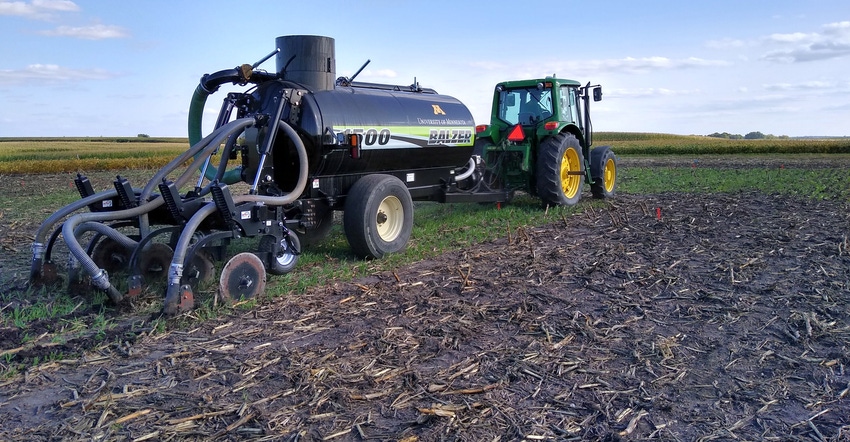
Most growers know the advantages of growing cover crops. It’s just a matter of getting the cover crop in the ground in the fall and then fertilizing to get it going, which can be challenging in places where it gets colder sooner.
In Minnesota, for example (or even parts of New York state or northern Michigan, for that matter) fall can get cold quick, leaving a short window for growers to get a cover crop planted — let alone having the ability to apply fertilizer or manure. But with warmer weather sticking around for longer, the question isn’t if you can get a cover crop established, but when.
At the recent North American Manure Expo, Melissa Wilson, associate professor of manure nutrient management and water quality, talked about a two-year project that compared cover crop establishment times, manure and fertilizer use, and the effects on yield to the following cash crop.
One system compared silage corn that had cover crops interseeded at either V4 or R5 corn, or drilled after corn harvest. Dairy manure applications were done in either early or late October, or a fertilizer was applied the following spring before planting.
A separate soybean plot had cover crops seeded either right before leaf drop, or drilled after harvest with various applications of swine manure or fertilizer measured.
Download now: In-depth cover crop guide available
Many growers in Minnesota apply manure or fertilizer in fall, Wilson said, but with temperatures staying warmer for longer periods of time, this can lead to nutrient loss. “The idea was to get cover crops in as soon as possible to get them going and capture the nutrients,” she said.
Another trial in sweet corn compared four cover crops — winter rye, oats, a rye-oats-radish mix and a plot where no cover crops were planted — as well as different fertilizer and swine manure applications.
In all trials, cover crop biomass was measured in fall and spring.
The cover crops were terminated in spring and tilled under before the following cash crop was planted.
Results
Whether seeded at V4 or R5, or drilled after corn, cover crops did establish, Wilson said. The amount of biomass varied. In fall, for example, the R5 seeding where manure had not been applied (fertilizer was planned for the spring) had the most biomass measured, followed by the V4 seeding without manure.
The plots with manure applied varied slightly in biomass measured and were not statistically different, she said. Not surprisingly, the plots where cover crops were drilled after corn produced the least amount of biomass.
Biomass was measured again the following spring in both years with the greatest amount measured in the R5 cover crop plots with no real difference whether manure was applied.
But what’s most significant, Wilson said, was the effect on corn silage the following year. The plots with manure applications showed higher corn silage yields — about 26 tons per acre — although the plots with fertilizer weren’t that much less. And there were not statistical differences showing the effects of cover crops in any of the plots.
Field corn followed the sweet corn plots. In 2020, yields ranged from 219 bushels in the early-manure plot to 266 bushels in the late-manure plots. The second-year yields were much more comparable, ranging from 213 bushels in the early-manure plot to 228 bushels in the fertilizer plot. Yield in the fertilizer-only plots averaged about 230 bushels per acre in both years.
Corn followed soybeans in the soybean plot. There wasn’t much difference on corn yield the following year. The fertilizer plots came in at 235 bushels, while the manured plots measured 230 bushels. Cover crops provided no statistical effect on yield.
Wilson said the plots showed that cover crops can be established early and provide some good biomass. It also showed that manure, depending on timing, can provide a good amount of nutrients to the following cash crop.
“We still have to work on an economic analysis, but overall we were really pleased, and we were really pleased at how manure performed compared to fertilizer,” she said.

Melissa Wilson, associate professor of manure nutrient management and water quality, talked at the recent North American Manure Expo about a two-year project that compared cover crop establishment times, manure and fertilizer use, and the effects on yield to the following cash crop.
The bottom line, Wilson said, is that there weren’t any negative effects on cash crop yields using manure, but having good equipment, whether it’s applying cover crop seed or applying manure, is crucial. Wilson said they used a small sweep manure injection system that opens a pocket of soil and sets the soil back on top.
“Equipment matters,” she said. “Another take-home message is if you’re worried about doing this, start small but be persistent. Different weather conditions can give you different results, but eventually you’ll find something that works on your farm.”
About the Author(s)
You May Also Like






